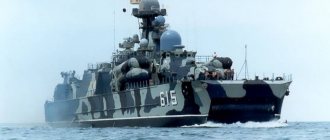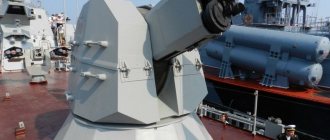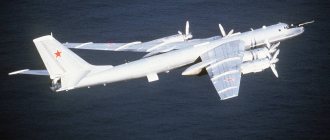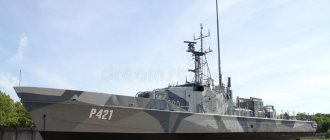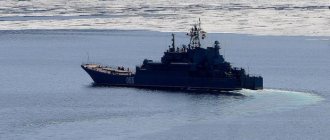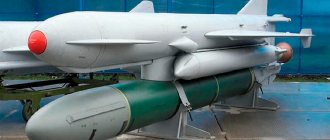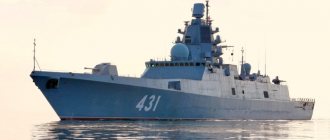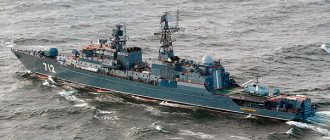Characteristics of small missile ships of Project 1234 "Gadfly"
A country:USSRType:Small rocket shipDate of issue:1967Displacement:Standard: 640 t, full: 730 tLength:59.3 m (largest)Width:11.8 m (largest)Draft:3.02 mReservations:NoCrew:64 people (10 officers, 14 midshipmen, 40 sailors)Power point:3 M-507A diesel engines with a capacity of 10,000 hp. With. Travel range:415 miles (full speed), 4000 miles (economy, 12 knots)Maximum speed:34 knots (actually up to 38 knots)Weapons:1 × 1x 76-mm AU AK-176, 1 × 6x 30-mm ZAK AK-630, 6 launchers of P-120 “Malachite” anti-ship missiles, “Osa-M” air defense systemAir group:No
Characteristics are given for project 1234.1
History of the creation of small missile ships of Project 1234 "Gadfly"
In the 60s of the 20th century, the Soviet Navy faced a big task - it didn’t even need a new ship, but a new type of ship - an intermediate link between missile cruisers and missile boats (RKA). Small missile ships (SMRs) , as they were dubbed, were supposed to be small, inexpensive, but at the same time seaworthy, long-range and very powerful combat units.
The tactical and technical specifications were approved on August 17, 1965 (TsMKB Almaz) and envisaged the creation of not yet an RTO, but an RKA, but already having all the features of the former. The ship was assigned project number 1234 and the code "Gadfly" , Ivan Petrovich Pegov was appointed chief designer, and captain 1st rank V.V. was appointed chief observer from the Navy. Dmitriev.
The problem solved by the designers was complex - into the relatively small displacement of yesterday’s boat it was necessary to “shove” a virtually full-fledged “ship” kit: two launchers of Malachite anti-ship missiles (each of the 6 missiles weighs 5.4 tons), a target designation radar complex “ Titanit", electronic warfare equipment, the Osa-M anti-aircraft missile system and the AK-725 artillery mount.
There was no turbine suitable for the power and dimensions for the new ship yet, so an original solution was found to install a three-shaft main power plant with two M-504 type diesel engines running on each shaft. successfully combined two M-504s into one M-507, resulting in an “engine” of 112 cylinders capable of producing 10,000 horsepower. There were three such engines in total.
The resulting “monster” did not fit into the very vague definition of “missile boat” in any way. Commander-in-Chief of the Navy S.G. Gorshkov, the main guardian of the fate of the Gadfly, approved a new class specifically for Project 1234 - “small rocket ships”. When the first of them (“Storm”) was launched, visiting it, the commander-in-chief proudly said, “these RTOs are a gun at the temple of imperialism.”
MRK "Storm" from the stern
And I must say - S.G. Gorshkov did not sin against the truth. Not a single fleet had anything that could even closely compare in terms of the complex of characteristics with the Gadflies - is it a joke, a ship with the dimensions of a river vessel, capable of sinking an enemy aircraft carrier almost single-handedly? And this is with incommensurable production costs - precisely in terms of this parameter (cost/efficiency), even now, in the 21st century, Project 1234 ships have no analogues in the world.
"Gadflies" are not only attack ships, but also successfully cope with other combat missions - they support the operation of aviation and submarines, perform border service, and act as anti-submarine and patrol ships.
Project 1234 is also not without its shortcomings - the ships do not feel comfortable on the open sea, when the sea level is 5, they do not listen well to the rudder and are practically deprived of the ability to fire with the “main caliber”. Relatively weak air defense (see the history of the service of the ships "Monsoon" and "Ein Zakit"), low autonomy, difficulties with cooling the engines when operating in ice - all this cannot be considered signs of an ideal ship.
However, despite all the shortcomings of the Gadfly, this “pistol” is trouble-free and always hits the target - the success of launches and the accuracy of hitting targets (taking into account the large number of ships themselves and, even more so, missile launches) fall short of 100%.
MRK "Passat" from the stern
Defensive arc
According to the vice-president of the Academy of Geopolitical Problems, Colonel Vladimir Anokhin, a strategic defensive arc is now being created in the Far East: Vladivostok - Kuril Islands - Sakhalin-Kamchatka.
“As expected, the defense is layered,” the expert told Izvestia. “On the distant approaches to the Russian coast, enemy ships, aircraft and landing craft will be met by the fleet with air support. Then - the new coastal missile systems "Bal" and "Bastion", the latter of which can destroy ships at a distance of up to 500 km. Directly on land, the enemy landing force will have to face the coastal forces of the Pacific Fleet. It is almost impossible to break through such a multilayer shield.
Kamchatka occupies a special position in this defensive configuration. An important part of the Northern Sea Route is controlled from its territory. We should not forget about the strategic submarine missile cruisers with nuclear weapons based on the peninsula.
Russia needs such an arc, since the situation in the region can hardly be called calm, recalled Vladimir Anokhin. According to him, Japan has not yet given up its dream of getting the Kuril Islands. And the United States has many military bases nearby, including in South Korea.
MRKs are well suited for use in inland seas and the coastal zone, says former Chief of the Main Staff of the Navy, Admiral Valentin Selivanov.
“They are needed in order to prevent foreign ships from approaching our naval bases,” he told Izvestia. — Foreign fleets have always had an interest in Kamchatka. In Vilyuchinsk there is a base of submarine missile cruisers with nuclear weapons, which the Gadflies will also have to cover. The submarines are part of Russia's strategic nuclear forces. RTOs will also participate in activities to ensure that these missile carriers go to sea.
Modifications and production of Project 1234 small rocket ships
- According to project 1234 “Gadfly”, 17 ships (Leningrad) + 3 (Vladivostok) were built. The last 3 “Leningrad” MRKs were converted to project 1234E.
- According to project 1234E (“Ovod-E”) - an export version, distinguished by the installation of 2 x 2 container installations of P-15 “Termite” anti-ship missiles (ASM), instead of 2 x 3 x Malachite anti-ship missiles. A total of 7 MRKs were built for Algeria and Libya (3 Gadfly converted to 1234E were delivered to India, they are mentioned above).
- In 1974, Project 1234.1 (improved) was developed with reinforced artillery weapons in the form of a 76-mm AK-176 mount and a 30-mm AK-630 anti-aircraft gun, and more modern electronic weapons, improved crew living conditions, and fire resistance of the hull. 15 ships were built for the USSR Navy and 1 unfinished one was dismantled on the slipway.
- In 1982, Project 1234.7 (experimental) was developed. It was created to test more advanced anti-ship missiles "Onyx", which constituted its main armament. 1 ship built.
- In 1999, project 1234EM (modernization) was developed. Modernization project for previously sold ships 1234E. The main striking force of the ship was 4 launchers with 16 Uran-E anti-ship missiles, and the onboard equipment complex was also changed. 1 ship for Algeria has been modernized.
A total of 47 ships of all projects were built.
MRK project 1234.1 “Passat” and “Zyb”, 2008
How many will they build?
Project 22800 "Karakurt" is a series of multi-purpose missile and artillery ships in the near sea zone, developed by specialists from the St. Petersburg Central Marine Design Bureau "Almaz". Already three ships of the series (Mytishchi, Sovetsk and Odintsovo) are serving in the Baltic Fleet. One of the features of these ships was the short construction period. This is explained by the fact that only proven serial solutions were used in the project. In total, it is planned to build 18 Project 22800 vessels, which will be distributed between the Pacific, Baltic and Black Sea fleets.
The ships of the Karakurt project were developed as a complement to the MRK of the modernized Buyan-M series. The ships “Karakurt” and “Buyan” have a displacement of approximately 850 and 950 tons. One of the main advantages of the Project 22800 ships is their maneuverability and speed.
Description of the design of Project 1234 ships
The ships have a smooth-deck hull with boat-like lines; the hull material is high-strength steel. The hull has a double bottom and is divided by nine bulkheads into 10 watertight compartments. Unsinkability is maintained when two adjacent compartments are flooded.
The superstructure is island, three-tiered.
Service and living quarters are located in the superstructure, on the main deck and on two platforms. The commander's cabin is located at the bow end of the first tier of the superstructure and consists of an office, a bedroom and a bathroom. The foremen's wardroom can be used as an operating room if necessary.
There is one four-legged truss-type foremast made of light-alloy pipes on the deck. On ships of Project 1234.1 it is more developed. The mast contains radio and communications antennas, signal halyards and navigation lights, and radar station antennas.
Export MRK - project 1234E
The main power plant is located in two engine rooms - bow (2 engines on the side shafts) and stern (1 engine on the middle propeller).
The MRKs are equipped with 2-4 PK-10 “Brave” passive jamming launchers and 2-4 PK-16 launchers. The latter is fired with 82-mm turbojet anti-radar jamming projectiles RUMM-82 (TSP-60). False radar targets can be placed at ranges from the ship ranging from 0.5 to 3.5 km, and thermal targets - at ranges from 2 to 3.5 km at altitudes from 100 to 1600 m. The weight of the TSP-60 projectile depending on equipment is 8.76-8.92 kg, flight range is 3500 m. For the PK-10, a 120-mm projectile weighs up to 25 kg and is launched from a installation with 10 guide tubes.
MRK "Rassvet" at the parade in Severomorsk, 2005
The Titanit (later Monolit) integrated radio system provides active and passive target detection and reception of information from aviation air surveillance and direction finding systems. The large antenna radome on the superstructure ensures operation in the first two modes. “Titanit” is interfaced with the “Danube” device, which ensures the preparation and launch of “Malachite” missiles. The detection range of surface targets is at least 40 km, and the over-the-horizon detection range is more than 100 km.
What did you experience?
The ship's life support, energy and survivability systems, autonomous operation of communications, ventilation and air conditioning, speed, maneuverability and stability of the ship were tested. The ship successfully tested radar and radio-electronic weapons, as well as artillery and anti-aircraft weapons. At the naval training ground, live firing took place at both small and maximum angles of rotation and elevation against simulators of sea, coastal and air targets.
MRK "Cyclone". Photo: Still from YouTube
Currently, the Cyclone is undergoing an audit of ship systems, devices and mechanisms, and the RTO is being prepared for the final stage of state tests, which begin at the end of January.
Features of project 1234.7
The main strike complex on the Nakat MRK (the only ship of Project 1234.7) is represented by two six-charge SM-316 launchers. Each SM-316 is an inclined truss structure to accommodate six SM-324 transport and launch containers for Onyx anti-ship missiles.
The anti-aircraft armament of the Nakat MRK is represented by the ZIF-122 bow launcher (deck-mounted, rotary) of the Osa-MA anti-aircraft missile system with an ammunition load of 20 9MZZ anti-aircraft missiles and a 4KZZ control radar.
The artillery armament is located at the stern of the ship and consists of: a 76-mm AK-176 AU with 316 rounds of ammunition and a six-barreled 30-mm AK-630M AU with an ammunition capacity of 3,000 shells. An artillery fire control radar “Vympel” (MR-123/176) is installed on the roof of the 1st tier of the superstructure.
Standard electronic weapons are represented by the Monolit complex, the Don-2 navigation radar, the Spektr-F laser warning system (with four sensors), the Vympel-R2 electronic warfare system and two PK-16 launchers.
MRK project 1234.7 "Nakat" - installations of new Oniks missiles are clearly visible
Purpose
The main combat mission of Project 22800 ships is to destroy critical targets in the near sea zone and destroy enemy surface forces. The Karakurt can perform such tasks either alone or as part of strike groups of the Russian Navy. Equipping with high-precision cruise missiles, and in the future, hypersonic weapons, significantly expands the capabilities of ships of this class and allows them to be used as a strategic deterrent.
https://function.mil.ru/news_page/country/ [email protected]
Features of the 1234EM project
In the mid-90s of the 20th century, the Almaz Central Marine Design Bureau developed (chief designer Yu.V. Arsenyev) a project for the modernization of Project 1234E ships, commissioned by Algeria. The main strike complex of the ship was 4 launchers with 16 Uran-E anti-ship missiles. A six-barreled 30-mm AK-630M artillery mount was installed in the aft part of the superstructure; on the roof of the cabin, instead of a Rangout-type radar, an antenna of the Harpun-E radar complex was installed. A three-dimensional general detection radar of the “Positive-ME-1” type was placed on the mast (the absence of the characteristic “cap” of “Gadflies”), a weapon control radar “Laska”, an optical-electronic gun mount control system “Rakurs” and a radio navigation system “Gorizont-25” were installed " In St. Petersburg, 1 ship for the Algerian Navy was modernized under this project.
Modernized Algerian MRK project 1234EM. The appearance of the ship has changed noticeably.
• Directory of the Navy • Ships of the same period • Russian Navy •
Source: compilation based on open sources on the Internet and books by V.V. Kostrichenko, V.E. Kuzmichev “A gun at the temple of imperialism”, Moscow, 2006.
